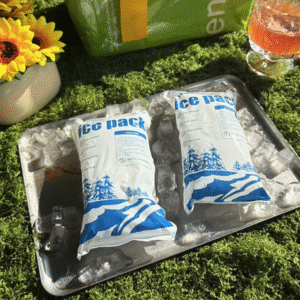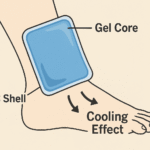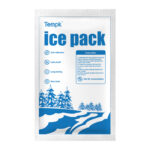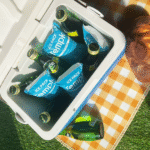Paquetes de hielo seco para la cocina: ¿Cómo se usan correctamente??
Actualizado en octubre 2025.
[Introducción:
Si manejas preparación congelada, supermercado, o catering, bolsas de hielo seco de cocina Te brinda potencia en frío intenso sin ensuciar el agua.. Esta guía le muestra cómo elegir, tamaño, y empaquételos para que su comida se mantenga sólida a -20°C o menos. Cubriremos matemáticas rápidas, diseños más geniales, seguridad, y 2025 tendencias. Saldrás con plantillas listas para aplicar y una breve lista de verificación que puedes entrenar en minutos.]
-
Conceptos básicos de tallas para bolsas de hielo seco de cocina con un método del reverso del sobre
-
Plantillas de embalaje para neveras portátiles y contenedores que utilizan palabras clave de cola larga relacionadas
-
Consejos de cumplimiento y manipulación para que el CO₂ se mantenga seguro en el hogar o en la cocina profesional
-
Indicadores de costes y sostenibilidad que reducen el desperdicio y aceleran la formación
-
Configuraciones híbridas que mezclan PCM y gel con bolsas de hielo seco de cocina
¿Qué son las bolsas de hielo seco para la cocina y cuándo se deben utilizar??
Respuesta corta: bolsas de hielo seco de cocina Son módulos preenvueltos llenos de hielo seco de CO₂ que ventilan el gas mientras mantienen la forma.. Actúan como “baldosas” ordenadas que esparcen el frío uniformemente en las neveras portátiles., totalizadores, o carros de servicio. Úselos cuando necesite confiabilidad congelada, fácil limpieza, y diseños predecibles. Dos victorias rápidas: Textura de helado más estable y transporte más seguro para pasteles congelados..
Detalles que puedes usar: Piense en los gránulos sueltos como arena., bloques como ladrillos, y bolsas de hielo seco de cocina como tejas flexibles. Los azulejos llenan las esquinas, mantén una cara fría y plana, y reducir las quemaduras por frío en los envases. Son ideales para laboratorios de pastelería., heladerías, mostradores de carnicero, y empresas de catering que preparan la comida con horas de antelación. Si su objetivo es de -20 °C a -30 °C durante 6 a 48 horas, ellos brillan. Para rutas largas u olas de calor, combine baldosas con un bloque pequeño y mejor aislamiento.
Paquetes de hielo seco para cocina versus paquetes de gel para uso doméstico y profesional
inmersión más profunda: Los paquetes de gel son para rangos fríos como 0-8°C. Son excelentes para productos agrícolas y bebidas., pero no pueden alcanzar temperaturas de hielo seco. bolsas de hielo seco de cocina alcanzan los -78,5°C en la fuente y mantienen la textura congelada incluso mientras se subliman. Para cajas mixtas, aislar los elementos que no deben congelarse con un deflector de cartón o una almohadilla de cambio de fase delgada, Luego rodea el exterior con bolsas de hielo seco de cocina.
| Opción de enfriamiento | Mejor para | No es genial para | Lo que significa para ti |
|---|---|---|---|
| bolsas de hielo seco de cocina | Helado, carnes congeladas, pasteles | Verdes de hoja, bayas frescas | Congelado permanece congelado; evitar el contacto directo |
| Pellets sueltos | Centros de alto volumen, dosificación rápida | Paquetes ordenados | Necesita revestimientos; puede cambiar durante el tránsito |
| Bloques/losas | Largos tiempos de espera | Cobertura precisa | Colocación duradera pero menos flexible. |
| Gel/PCM +5°C | Bebidas frías, ensaladas | Helado | No alcanzará los objetivos de -20°C |
Consejos prácticos para las bolsas de hielo seco en la cocina
-
Carreras de helado: Lugar baldosas de hielo seco arriba; el aire frío se hunde sobre las bañeras.
-
Capas de pastelería: Utilice una tabla espaciadora para evitar anillos fríos.; Los azulejos en la tapa dan una parte superior más suave..
-
Protección de comestibles: Mantener congelado por un lado, helado por el otro; agregar un deflector entre zonas.
Caso del mundo real: Una heladería cambió a baldosas de hielo seco forrado en la tapa y los lados. La pérdida de textura disminuyó notablemente en los días de 35°C, y el personal empacó cada hielera 90 segundos más rápido.
¿Cómo se dimensionan las bolsas de hielo seco de la cocina para su hielera??
Respuesta corta: Empieza por la fuga de calor de tu caja., luego iguala la capacidad. bolsas de hielo seco de cocina Absorbe calor cuando el CO₂ se convierte en gas.. Calcule su carga de calor por hora, multiplicar por horas, y dividir por la energía absorbida durante la sublimación. Agregue entre un 10 % y un 30 % de tampón para aberturas de puertas, retrasos, y error humano.
Detalles que puedes usar: No necesitas equipo de laboratorio. Trate la hielera como un termo con fugas. Más superficie, aislamiento inferior, y un ambiente más cálido significa más fugas. Un modelo simple y una prueba de un carril lo acercarán, y bolsas de hielo seco de cocina hacer que el diseño sea repetible para cualquier persona en turno.
Una calculadora de bolsillo para bolsas de hielo seco en la cocina.
Ejemplo: Una hielera dura de 50 cuartos (A≈0,8m², R≈0,45) a 32°C durante 18 h:
Q≈(0.8/0.45)×52≈92.4W → m≈(92.4×18×3.6)/571≈10,5kg. Agregar 20% → ~12,6 kg. Utilice un bloque pequeño en la parte inferior y bolsas de hielo seco de cocina como cortinas laterales y una capa de tapa ventilada.
| Variable | rango típico | como elegir | Para tu cocina |
|---|---|---|---|
| Valor R (refrigerador suave) | 0.2–0,35 | Utilice las especificaciones del fabricante o una prueba rápida | Puede que necesite más mosaicos |
| Valor R (enfriador duro) | 0.35–0,6 | Los sellos de tapa más ajustados obtienen una puntuación más alta | Temperatura más suave |
| Valor R (Inserción VIP) | 2.0–3.0 | Actualización premium | Reduce mucho el CO₂ necesario |
| Buffer | 10–30% | Las nuevas rutas necesitan más | Seguro contra retrasos |
Consejos prácticos para las bolsas de hielo seco en la cocina
-
Paseos cortos (<8 H): Favor bolsas de hielo seco de cocina para una cobertura uniforme; saltar losas pesadas.
-
Cabinas de autos calientes: Doble mosaico en la pared orientada al sol.; mantenga los paquetes alejados de los productos agrícolas con un deflector.
-
Eventos: Coloque una capa adicional en el párpado bolsas de hielo seco de cocina para horas pico.
Caso del mundo real: Se agregó un proveedor de catering para bodas. 15% más bolsas de hielo seco de cocina en la tapa. En un día de 38°C, los postres se mantuvieron firmes durante el servicio al aire libre sin daños por glaseado.
¿Las bolsas de hielo seco de cocina son seguras para la manipulación y almacenamiento de alimentos??
Respuesta corta: Sí, cuando respetas las reglas de ventilación y tacto. bolsas de hielo seco de cocina liberan gas CO₂ a medida que se calientan. Dale un camino al gas, proteger las manos y los ojos, y mantenga las mochilas alejadas de los niños y las mascotas. Nunca atrapes hielo seco en recipientes herméticos.; la presión puede aumentar.
Detalles que puedes usar: El CO₂ desplaza al oxígeno. Trabajar en habitaciones bien ventiladas, no autos sellados ni despensas diminutas. Utilice guantes para evitar quemaduras por frío., y evitar tragar cualquier fragmento. Mantenga los paquetes fuera del envoltorio principal para alimentos a menos que estén clasificados para contacto directo.. Marque la masa de CO₂ estimada en envíos grupales. Para viajes más largos, Abre una ventana y evita reclinarte cerca de las rejillas de ventilación..
Paquetes de hielo seco para la cocina: ventilación, PPE, y etiquetado
inmersión más profunda: Una tapa con ventilación o un pequeño espaciador en la bisagra es suficiente para la mayoría de las neveras portátiles.. Un kit básico de guantes y protección ocular protege a su equipo durante los períodos de preparación más ocupados.. Etiquete los refrigeradores compartidos como "Contiene hielo seco" para que todos sepan que deben evitar espacios sellados.. Girar bolsas de hielo seco de cocina con pinzas o una pala para evitar el contacto con la piel y mantener los fragmentos contenidos.
| Tema de seguridad | Buena practica | Por que importa | Para ti |
|---|---|---|---|
| Desfogue | Deje un pequeño espacio o use una tapa ventilada | El gas debe salir | Previene el aumento de presión |
| PPE | Guantes y protección para los ojos. | Detiene las quemaduras por frío | Más rápido, turnos más seguros |
| Almacenamiento | Aislado, contenedor ventilado | Controla la sublimación | Menos niebla y desorden |
| Vehículos | ventana grieta; Evite los baúles sellados. | Evite la acumulación de CO₂ | Viajes largos más seguros |
Consejos prácticos para las bolsas de hielo seco en la cocina
-
cocina casera: Lugar baldosas de hielo seco en una bandeja; limpie la condensación para mantener los mostradores secos.
-
Espacios compartidos: Publique un POE de una página cerca de la mesa de preparación.; agregar una lista de verificación para abrir y cerrar.
-
Desperdiciar: Deje que el hielo seco restante se disipe en un área ventilada.; nunca en un lavabo o inodoro.
Caso del mundo real: Después de agregar un POE de una página y contenedores claramente etiquetados, una panadería reportó cero lesiones en las manos en todo 90 días de producción de verano mientras se usa bolsas de hielo seco de cocina a diario.
¿Cómo ayudan las bolsas de hielo seco a la cocina a la restauración y a los eventos??
Respuesta corta: Hacen que el frío sea predecible. bolsas de hielo seco de cocina estandarizar los paquetes y el entrenamiento de velocidad. Puedes construir simples, diseños repetibles para platos principales, postres, y barra de hielo que se mantiene durante horas incluso con aperturas frecuentes de la tapa..
Detalles que puedes usar: Utilice azulejos en la tapa porque el aire frío se hunde.. Coloca cortinas laterales que protejan la pared más caliente.. Para postres emplatados, agregue un tablero espaciador entre el producto y la capa superior. Para proteínas crudas, mantenga un revestimiento entre el embalaje y las losetas para evitar el contacto directo. Codifique con colores los refrigeradores por curso y asigne un temporizador para cada uno..
Un diseño de refrigerador las 24 horas que utiliza bolsas de hielo seco para la cocina
Plantilla que puedes copiar:
Por que funciona: La capa superior inunda la nevera con aire frío.. Las cortinas laterales protegen contra el calor radiante de las puertas y la luz solar.. La tabla espaciadora evita que el borde de la tapa se queme en artículos delicados como merengue o mousse..
| Tipo de carga | Cambio de paquete | Efecto de tiempo de espera | Tu beneficio |
|---|---|---|---|
| Helado | Capa adicional en la tapa | Ventana extensible más larga | Mejor textura, menos goteo |
| Pasteles | Tablero espaciador debajo de los azulejos de la tapa. | Detiene los anillos de escarcha | Enchapado más bonito |
| Proteínas | Revestimiento entre paquetes y carne. | Separación segura | Ruta HACCP más limpia |
Consejos prácticos para las bolsas de hielo seco en la cocina
-
Kits de curso: Asignar bolsas de hielo seco de cocina solo a postres; Utilice gel para ensaladas para evitar la congelación..
-
Servicio de barra: Utilice baldosas para preenfriar los recipientes de cristalería; Retire las baldosas antes del servicio para evitar un enfriamiento excesivo..
-
Viajes de regreso: Mantenga una funda con cremallera de repuesto bolsas de hielo seco de cocina para estabilizar las sobras.
Caso del mundo real: Un equipo de banquetes de hotel con refrigeradores codificados por colores y diseños estandarizados con bolsas de hielo seco de cocina. El tiempo de configuración se redujo 20%, y los residuos posteriores al evento disminuyeron notablemente.
¿Las bolsas de hielo seco para la cocina funcionan con PCM y paquetes de gel??
Respuesta corta: Sí. Construir híbridos. bolsas de hielo seco de cocina suministrar capacidad de frío profundo, mientras que los materiales de cambio de fase (PCM) o gel gestionan puntos de ajuste precisos y protegen los artículos sensibles del sobrecongelamiento.
Detalles que puedes usar: Si envía o transporta artículos que no deben bajar de -10°C, Coloque una losa delgada de PCM a -21 °C contra el producto y rodéela con bolsas de hielo seco de cocina. Para cajas mixtas, ejecutar un refrigerador de doble zona: gel o PCM en un lado para enfriar, azulejos en el otro para congelados. Los deflectores de cartón y los tableros espaciadores evitan que las zonas peleen entre sí..
Paquetes híbridos con bolsas de hielo seco para cocina
Recetas de inicio:
| Meta | capa interior | capa exterior | Por qué ayuda |
|---|---|---|---|
| Protege los postres frágiles | Plancha PCM −21°C | bolsas de hielo seco de cocina | Previene el agrietamiento de la superficie |
| Congelado mixto + enfriado | Gel +5°C por una cara | Azulejos del otro lado | Dos zonas, un refrigerador |
| Marinado de proteínas | Envoltorio apto para alimentos | Azulejos en la tapa y los lados. | Mantiene temperaturas seguras |
Consejos prácticos para las bolsas de hielo seco en la cocina
-
Eventos solo fríos: Evite el hielo seco y use paquetes de gel.; reservar bolsas de hielo seco de cocina para cursos congelados.
-
Cortes de energía: Utilice azulejos en el congelador para mantener la temperatura.; coloque un termómetro en el estante superior.
-
Días de entrega: Escenario bolsas de hielo seco de cocina cerca de la puerta para que los alimentos permanezcan congelados durante la descarga.
Caso del mundo real: Durante un apagón en toda la ciudad, un café estabilizó tres alcances cargando bolsas de hielo seco de cocina en los estantes superiores y manteniendo las puertas cerradas. Las existencias se mantuvieron seguras hasta que volvió la energía.
2025 Tendencias en bolsas de hielo seco para la cocina que debes conocer
Descripción general de la tendencia: En 2025, Las empresas alimentarias quieren neveras portátiles más ligeras., entrenamiento más rápido, y preparación más limpia. bolsas de hielo seco de cocina encajar en esa curva. Espere más envolturas con menos polvo, costuras más fuertes que resisten el desgarro, y mosaicos estandarizados de tamaño para refrigeradores populares. Sensores más inteligentes verifican los tiempos de espera sin abrir las tapas, y los pequeños insertos VIP hacen que las neveras compactas se comporten como cajas premium.
Novedades de las bolsas de hielo seco para la cocina
-
Envolturas más limpias: Menos polvo de CO₂ en las mesas de preparación y limpieza más rápida.
-
Dimensionamiento modular: Los mosaicos que coinciden con las huellas de los refrigeradores comunes reducen el espacio desperdiciado.
-
Validación del sensor primero: Los registradores inalámbricos demuestran su rendimiento sin abrir la tapa.
Insight del mercado: Los consumidores compran alimentos congelados con más frecuencia, y las cocinas pequeñas añaden eventos fuera del sitio. Esa presión empuja a los equipos hacia diseños repetibles.. bolsas de hielo seco de cocina ayude a defender la textura y la seguridad alimentaria con menos pasos, y los paquetes híbridos reducen la sobrecongelación de artículos delicados y al mismo tiempo mantienen los productos ultracongelados sólidos como una roca..
Preguntas frecuentes
Q1: ¿Cuánto tiempo duran las bolsas de hielo seco de cocina en una hielera??
Depende del aislamiento, calor ambiental, y aberturas de tapa. Un buen refrigerador duro con bolsas de hielo seco de cocina puede contener artículos congelados durante uno o dos días. Siempre prueba tu ruta, luego agregue un búfer del 10 al 30%.
Q2: ¿Las bolsas de hielo seco de cocina son seguras para niños y mascotas??
Utilice únicamente el manejo de un adulto. Usar guantes, mantener los paquetes fuera del alcance, y salas de ventilación. Nunca atrapes hielo seco en frascos sellados ni lo pongas en bebidas.. Permita que el CO₂ se disipe de forma segura.
Q3: ¿Puedo volar con bolsas de hielo seco de cocina en el equipaje facturado??
Las reglas de las aerolíneas generalmente permiten cantidades limitadas de hielo seco con ventilación y etiquetado adecuados.. Consulta los límites del transportista y declara la masa neta.. Use un contenedor ventilado.
Q4: ¿Las bolsas de hielo seco de la cocina harán que mis productos se congelen??
ellos pueden. Mantenga las baldosas alejadas de elementos que deban permanecer fríos.. Utilice gel o PCM para proteger las verduras y las frutas., y agregar un deflector de cartón.
Q5: ¿Puedo usar bolsas de hielo seco de cocina en una hielera suave??
Sí, pero necesitarás más mosaicos que en un refrigerador rígido. Duplique las cortinas laterales y agregue una capa de tapa resistente para obtener mejores resultados..
Q6: ¿Las bolsas de hielo seco de cocina son seguras para el contacto con los alimentos??
Muchas envolturas no están diseñadas para contacto directo.. Mantenga los paquetes fuera del embalaje primario a menos que estén clasificados como seguros para el contacto con alimentos.. cuando no estoy seguro, agregar un forro.
P7: ¿Cómo desecho las bolsas de hielo seco sobrantes de la cocina??
Déjalos sublimar en un lugar bien ventilado., lejos de niños y mascotas. Never in sinks or drains. Do not confine or crush them.
P8: Do kitchen dry ice packs help during power outages?
Sí. Place tiles on the top shelf of the freezer and keep doors closed. Temperature stays lower because cold air sinks over the food.
P9: How should I store kitchen dry ice packs before use?
Utilice un aislamiento, contenedor ventilado. Avoid sealed rooms and keep PPE nearby. Rotar el material primero en entrar, first‑out to keep packs fresh.
Summary and recommendations for kitchen dry ice packs
Control de llave: Usar bolsas de hielo seco de cocina for frozen reliability, manejo limpio, and fast training. Size by heat leak, no conjeturas. Vent and label to keep people safe. Combine tiles with gel or PCM when you need mixed zones. Estandarizar los paquetes, then test and tune.
Siguientes pasos: Choose your cooler class, run the simple mass estimate, and pilot two pack‑out templates on your hottest route. Record results and lock the SOP. If you want a custom layout and a lane test, talk to Tempk for a data‑backed design.
Acerca de Tempk
Tempk builds practical cold‑chain designs for home and professional kitchens. We help teams deploy bolsas de hielo seco de cocina, hybrid layouts, and validation tools that reduce waste and training time. Customers see steadier quality and fewer temperature excursions during transport and service.
Llamado a la acción: Contact Tempk to schedule a 2‑week pilot and get a pack‑out tailored to your routes and coolers.
Engagement boosters for kitchen dry ice packs
-
3‑Question Selector:
-
Do you need ≤ −20 °C? En caso afirmativo, elegir bolsas de hielo seco de cocina.
-
Ruta >24 h or hot car? Add a small block and double the lid layer.
-
Freeze‑sensitive items present? Buffer with PCM or a cardboard baffle.
-
-
Rúbrica de autoevaluación (puntuación de 0 a 5 cada uno): masa correcta, clase de aislamiento, ruta de ventilación, handling PPE, y registro de datos. Score ≥20 → ready to run.
-
CTA: Download the cooler SOP and schedule a route test with our team.
























